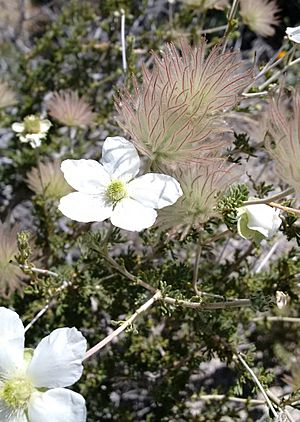Apache plume facts for kids
Quick facts for kids Apache plume |
|
|---|---|
 |
|
| Scientific classification | |
| Genus: |
Fallugia
|
| Species: |
paradoxa
|
The Apache plume (scientific name: Fallugia paradoxa) is a beautiful flowering plant. It's the only type of plant in its group, called a genus, which is named Fallugia. People also call it póñil. You can find this plant growing naturally in the southwestern United States and northern Mexico. It loves dry places like desert forests and scrublands.
Contents
What Apache Plume Looks Like
The Apache plume is a shrub that stands upright and can grow up to two meters (about 6.5 feet) tall. It has many thin branches covered in light gray or whitish bark that peels off.
Leaves and Flowers
- Each leaf is about one centimeter (less than half an inch) long.
- The leaves have deep cuts and their edges curl under.
- The top of the leaf is green and a bit hairy.
- The underside is not as bright and feels scaly.
When the flower first blooms, it looks like a small rose. It has round, white petals. In the middle, there are many thin stamens (the parts that make pollen) and pistils (the parts that receive pollen).
After the Flower Blooms
After the white petals fall off, the part of the flower that holds the seeds (called the ovary) stays behind. This part then grows many feathery, lavender-colored styles. Each style is about 3 to 5 centimeters (1 to 2 inches) long.
Sometimes, the plant can be covered with these dark pinkish groups of curling, feathery styles. Each style is connected to a small fruit that is developing. This fruit is called an achene, which is a small, dry fruit with one seed. When the wind blows, it catches these feathery styles and carries the fruits away, helping the plant spread its seeds.
Wasps, like the Polistes instabilis, often visit Apache plume flowers to feed on their sweet nectar.
How Apache Plume is Used
The Apache plume plant is very helpful for stopping erosion in desert areas where it grows. Erosion happens when soil is washed away by wind or water. The plant's roots help hold the soil in place, which is important for keeping the land healthy.
See also
 In Spanish: Fallugia para niños
In Spanish: Fallugia para niños

